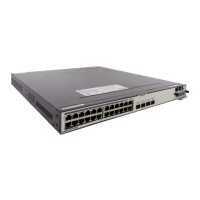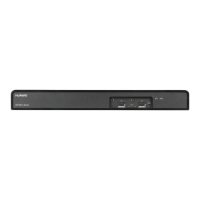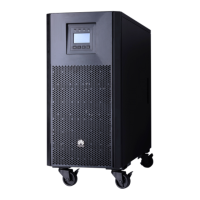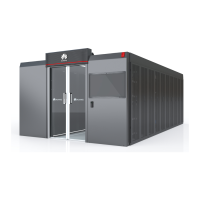1. Power off SwitchA, SwitchB, SwitchC, and SwitchD.
2. Connect SwitchA and SwitchB using a stack cable.
3. Power on SwitchA first. After SwitchA starts, power on SwitchB. Then run a display
command to check whether SwitchA and SwitchB set up a stack.
4. Connect SwitchC and SwitchB using a stack cable and power on SwitchC first. Connect
SwitchD to SwitchC and SwitchA using stack cables and then power on SwitchD.
Step 4 Verify the configuration.
# Check basic stack information.
<SwitchA> display stack
Stack topology type : Ring
Stack system MAC: 0018-82d2-2e85
MAC switch delay time: 10 min
Stack reserve vlan : 4093
Slot of the active management port: --
slot Role Mac address Priority Device type
-------------------------------------------------------------
0 Master 0018-82d2-2e85 200 S5700-28P-LI-AC
1 Slave 0018-82c6-1f44 100 S5700-28P-LI-AC
2 Standby 0018-82c6-1f4c 100 S5700-28P-LI-AC
3 Slave 0018-82b1-6eb8 100 S5700-28P-LI-AC
----End
4.2 Configuring a Stack for Bandwidth Expansion
Networking Requirements
As the network scale increases, switches on the network cannot provide sufficient uplink
bandwidth. You can add new switches to configure them to set up a stack with existing
switches and configure multiple physical links of member switches in the stack as a link
aggregation group to increase the uplink bandwidth of the switches.
As shown in Figure 4-2, SwitchA and SwitchB are two S6700-E1s and need to set up a stack
with a ring topology. Assume that SwitchA functions as the master switch and SwitchB
functions as the standby switch. To facilitate device management, set the stack ID of SwitchA
to 0 and the stack ID of SwitchB to 1. Connect XGigabitEthernet 0/0/5 and XGigabitEthernet
1/0/5 to access switches, and add XGigabitEthernet 0/0/20, XGigabitEthernet 0/0/21,
XGigabitEthernet 1/0/20, and XGigabitEthernet 1/0/21 to an Eth-Trunk to increase uplink
bandwidth.

